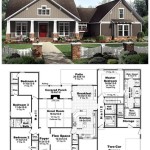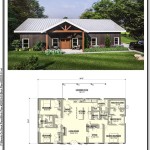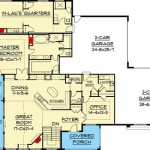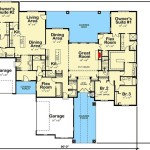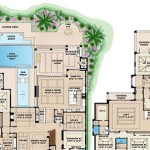Narrow 2 Bedroom House Plans: Maximizing Space and Functionality
Designing a narrow two-bedroom house presents unique challenges and opportunities. The constraints of a narrow lot demand careful consideration of spatial planning, natural light, and traffic flow. However, with intelligent design and strategic use of materials, a narrow lot can be transformed into a comfortable and functional home. This article explores key aspects of designing narrow two-bedroom house plans, focusing on strategies to optimize space, enhance livability, and create a visually appealing environment.
The primary goal of any narrow house design is to make the most of the limited width while ensuring the house feels spacious and functional. Careful consideration must be given to the placement of rooms, the orientation of the house, and the use of vertical space. The overall design should prioritize natural light and ventilation to create a comfortable and inviting living environment.
Strategic Space Planning for Narrow Lots
Space planning is arguably the most critical aspect of designing a narrow two-bedroom house. Efficient use of every square foot is essential to prevent the house from feeling cramped or claustrophobic. The following strategies are crucial for effective space planning:
Open Concept Living: Open concept living areas are highly effective in maximizing space in narrow houses. Combining the living room, dining area, and kitchen into a single, flowing space creates a sense of spaciousness and allows natural light to permeate throughout the entire area. The lack of walls also facilitates better cross-ventilation. Utilizing different flooring materials, varying ceiling heights, or strategically placed furniture can subtly define different zones within the open space without completely closing them off.
Verticality: Embracing verticality is a key principle in narrow house design. Instead of spreading out horizontally, consider maximizing the height of the rooms. High ceilings create a sense of openness and allow for taller windows, which can dramatically increase the amount of natural light entering the house. Mezzanine levels can be incorporated to add extra living space without expanding the footprint of the house. Strategic placement of storage solutions, such as floor-to-ceiling shelves, can also utilize vertical space efficiently.
Strategic Placement of Bedrooms: In a two-bedroom narrow house, the placement of the bedrooms is crucial. Consider placing the bedrooms at opposite ends of the house to provide privacy and minimize noise transfer. Another option is to locate one bedroom on the ground floor and the other on the upper floor, creating a distinct separation of living and sleeping areas. The master bedroom should ideally be positioned to capitalize on natural light and views, if available. Thoughtful placement of closets and built-in storage within the bedrooms can further optimize space and reduce clutter.
Multifunctional Spaces: Designing spaces that can serve multiple purposes is another excellent way to maximize functionality in a narrow house. For example, a guest room can double as a home office, or a dining area can function as a workspace when not in use for meals. Using furniture that can be easily reconfigured or stored away, such as folding tables or convertible sofas, allows for flexibility and adaptability. Incorporating built-in storage solutions, such as window seats with storage underneath or hidden compartments in furniture, can further enhance the functionality of these multi-purpose spaces.
Minimizing Hallways: Hallways consume valuable space and often contribute little to the overall functionality of a house. In narrow houses, minimizing hallway space is crucial. Consider designing a floor plan that minimizes the need for long corridors by strategically placing rooms to create a more direct flow of traffic. Entryways can be designed to function as transitional spaces, incorporating benches, storage, and coat racks to serve multiple purposes. Careful planning of circulation paths can significantly improve the efficiency of the floor plan and create a more spacious feel.
Optimizing Natural Light and Ventilation
Natural light and ventilation are crucial for creating a comfortable and healthy living environment in any home, but they are particularly important in narrow houses. The limited width of the house can often restrict the amount of natural light that can penetrate the interior, potentially leading to a dark and stuffy environment. To overcome this challenge, architects and designers utilize various strategies to maximize natural light and ventilation:
Large Windows and Skylights: Incorporating large windows and skylights is one of the most effective ways to bring natural light into a narrow house. Windows should be strategically placed to capture sunlight throughout the day. Skylights can be particularly useful in bringing light into areas that are difficult to illuminate with traditional windows, such as interior bathrooms or hallways. Consider using high-performance glass to minimize heat gain and loss. Casement windows or awning windows can provide excellent ventilation, even during light rain.
Light Wells and Courtyards: Light wells and courtyards can be incorporated into the design to bring natural light and ventilation into the center of the house. A light well is essentially a vertical shaft that allows sunlight to penetrate through multiple floors. Courtyards can create an outdoor living space and provide an additional source of natural light and ventilation. These features can be particularly effective in narrow houses where the depth of the house makes it difficult for natural light to reach the interior.
Open Floor Plans and Internal Glazing: As mentioned previously, open floor plans facilitate the flow of natural light throughout the entire house. In addition to open layouts, consider using internal glazing, such as glass walls or glass doors, to allow light to penetrate through interior spaces. Frosted or textured glass can be used to maintain privacy while still allowing light to pass through. Internal glazing can also create a sense of openness and connection between different areas of the house.
Light Colors and Reflective Surfaces: Using light colors on walls, ceilings, and floors can significantly enhance the amount of natural light in a narrow house. Light colors reflect light, making the space feel brighter and more open. Reflective surfaces, such as mirrors or glossy finishes, can also be used to bounce light around the room. Careful selection of materials and finishes can dramatically improve the overall lighting in the house.
Operable Windows for Cross Ventilation: Cross ventilation is crucial for maintaining a comfortable indoor climate. Operable windows should be strategically placed on opposite sides of the house to allow for natural airflow. Consider using windows with different opening mechanisms, such as casement, awning, or sliding windows, to maximize ventilation. The placement of windows should take into account prevailing winds to ensure optimal airflow.
Design Considerations for Livability and Aesthetics
Beyond space planning and natural light, several other design considerations are crucial for creating a livable and aesthetically pleasing narrow two-bedroom house. These include:
Exterior Design and Curb Appeal: While the interior layout is paramount, the exterior design also plays a significant role in the overall appeal of the house. The facade should be designed to be visually appealing and harmonious with the surrounding environment. Consider using a combination of materials and textures to add visual interest. The entrance should be welcoming and clearly defined. Landscaping can also enhance the curb appeal of the house, creating a more inviting and attractive facade. In narrow lots, attention to the vertical aspect of the facade can be key to making the house appear proportionally balanced.
Storage Solutions: Adequate storage is essential in any home, but it is particularly important in narrow houses where space is limited. Incorporating built-in storage solutions, such as shelves, drawers, and cabinets, can help to maximize space and reduce clutter. Consider utilizing unconventional storage spaces, such as under-stair storage or attic storage. Organizing storage spaces efficiently is also crucial. Using containers, dividers, and labels can help to keep storage areas neat and organized.
Material Selection and Finishes: The selection of materials and finishes can significantly impact the overall look and feel of a narrow house. Light-colored materials can help to create a sense of spaciousness and can reflect natural light. Durable and low-maintenance materials are ideal for high-traffic areas. Consider using sustainable and eco-friendly materials whenever possible. The overall aesthetic should be cohesive and reflect the homeowner's personal style.
Privacy Considerations: Privacy is an important consideration, particularly in urban environments where houses are often located close to each other. Carefully consider the placement of windows and doors to minimize views from neighboring properties. Use curtains, blinds, or shades to provide additional privacy. Consider incorporating landscaping elements, such as trees or shrubs, to create a natural privacy screen. Fences or walls can also be used to provide privacy and security.
Accessibility: When designing a narrow two-bedroom house, it is important to consider accessibility for all occupants, including those with mobility limitations. Incorporating features such as wider doorways, ramps, and grab bars can make the house more accessible. Ensure that there is adequate space for maneuvering wheelchairs or walkers. Consider designing a ground-floor bedroom and bathroom to accommodate individuals who may have difficulty climbing stairs. Universal design principles should be incorporated throughout the design to ensure that the house is accessible and comfortable for everyone.
By carefully considering these design principles and implementing creative solutions, it is possible to create a functional, comfortable, and aesthetically pleasing narrow two-bedroom house that maximizes space and enhances livability.

House Plan 40839 Narrow Lot Style With 740 Sq Ft 2 Bed 1 Bath

2 Bedroom 17 Foot Wide Home Plan

Narrow 2 Bedroom Floor Plan With Balcony

Traditional House Plan 2559 00204

House Plan 526 00041 Ranch 1 300 Square Feet 3 Bedrooms 2 Bathrooms

2 Story House Plans For Narrow Lots Blog Builderhouseplans Com

Narrow 2 Bedroom Floor Plan With Balcony

The Best 2 Bedroom Tiny House Plans Houseplans Blog Com
Small House Plans 9x7 With 2 Bedrooms Hip Roof Samhouseplans

Unique Small 2 Bedroom House Plans Cabin Cottage

